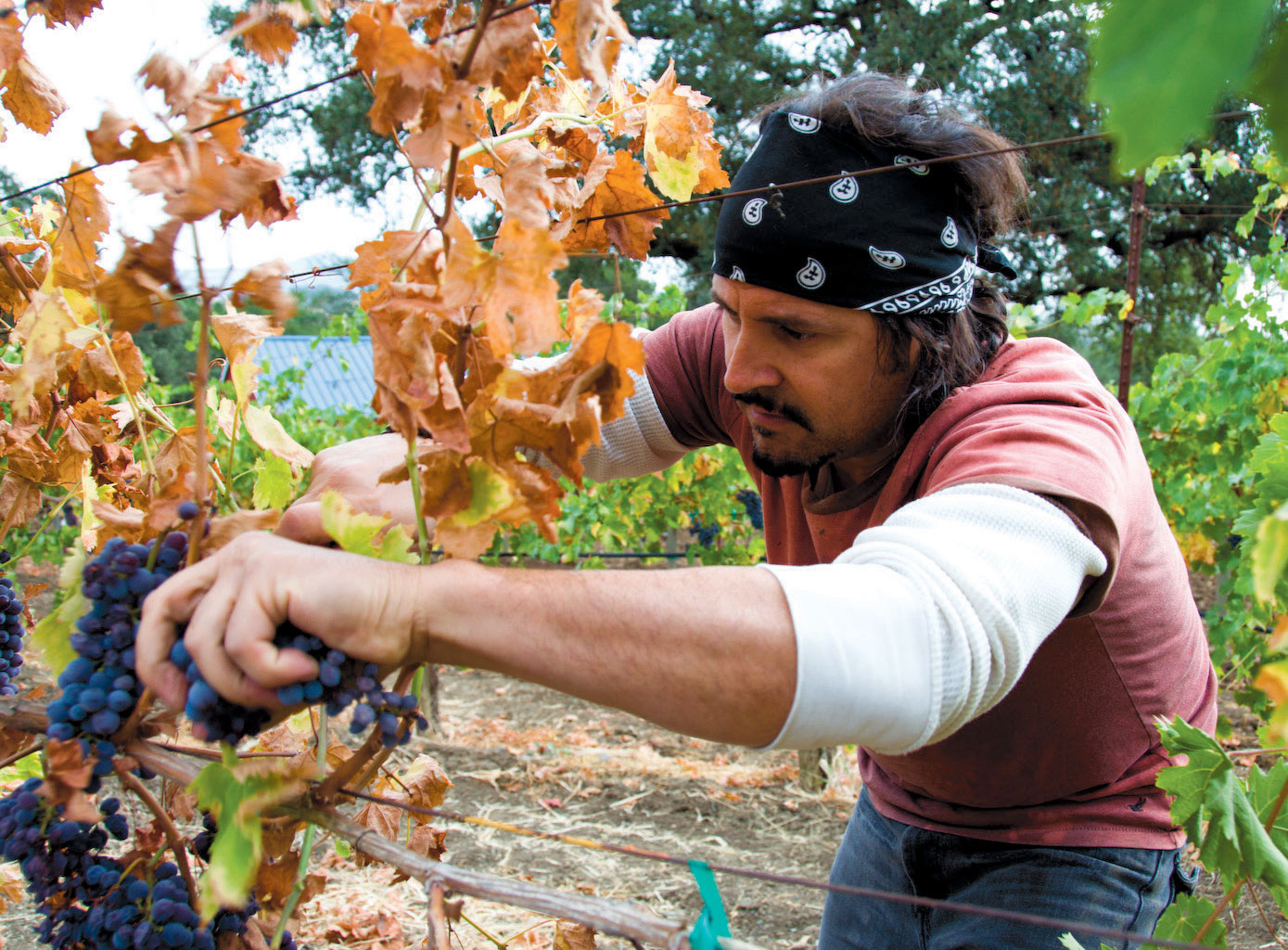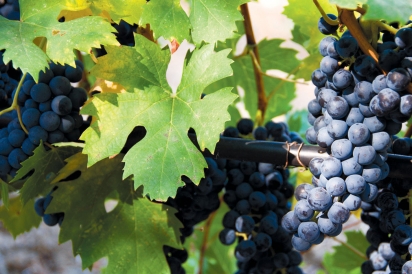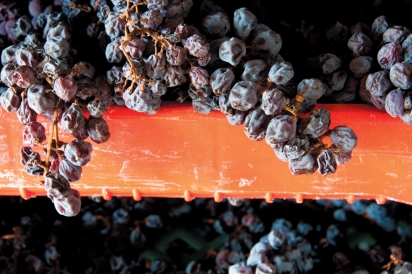Mora Estate
AN ITALIAN TREASURE FLOURISHES IN SONOMA
Valpolicella, a small valley that is home to a very big wine, Amarone della Valpolicella, is nestled just north of Verona and adjacent to Lake Garda in northern Italy.
This singular wine, made using an ancient method that involves letting the grapes rest for several weeks after harvest and prior to fermentation, is widely praised as Italy’s most distinctive, most precious wine.
It is also one of the treasures of Sonoma County.
Fabiano Ramaci founded his Windsor-based winery, Mora Estate, in 2009. The seeds of inspiration were planted decades earlier, while he was a teenager working at his father’s restaurant, San Francisco’s La Traviata, an old-school Italian eatery in the Mission District. It was there that he fell in love with the Italian wine.
“It was so sexy, so elegant,” he recalls, “and absolutely not ordinary.”
Today, he produces about 200 cases of the wine he christened Valporone.
The wine is made with the four primary varietals used in the wine that inspired him: Corvina Veronese, Rondinella, Molinara and Negrara. His grapes are grown on land he leases in three Sonoma County appellations: Alexander Valley, Dry Creek Valley and Russian River Valley.
Harvest is in October, when sugar levels are at 22.5 brix. He sorts the clusters by hand—at dawn, “as the moon is just sinking below the horizon,” he says—then places them on dozens of drying racks housed in a large barn in Fairfield. And then he waits for the next several weeks, as the nature works its magic. The grapes aspirate, losing about 50% of their moisture over 90 to 120 days. Varietals are not separated; they are a field blend, harvested, aged and fermented together.
The technique, known in Italy as appassimento, harkens back to ancient Rome, when grape harvests were often too big to ferment all at once. Instead, the grapes were carefully stored until there was space to make more wine. Today, the Italian wine is made under tightly controlled conditions, in temperature-controlled barns with motorized fans that sweep back and forth over racks of drying grapes.
As winter sets in, when most new wines are resting in barrels or tanks and winemakers are enjoying well-earned down time, Ramaci is watching over an extended 30-day maceration and fermentation. Depending on the year, he presses his wine in January or February. The new wine then spends 18 months in barrels of cherry wood and new French oak before it is bottled.
“It is Fabiano’s precision that captures the wine’s beauty,” says Chris Sawyer, sommelier at Gravenstein Grill in Sebastopol. “It takes a lot of space, care, attention and patience to make this wine. We are lucky to have him, with his ambition and Italian flair, in Sonoma County.”
Ramaci’s mentor is the late Giuseppe Quintarelli, known as the Maestro del Veneto, though Ramaci refers to him as the King of Amarone. Quintarelli’s winemaking career spanned more than six decades. After his death in early 2012, his nephew took the helm of his namesake winery, Quintarelli, known for its traditional wines of uncompromising quality. Quintarelli Amarone della Valpolicella is made only in years when the grapes are of exceptional quality. They rest, as Ramaci’s do, before undergoing a 45-day fermentation. After the wine is racked, it is aged in barrels of Slovenian oak for seven years. Once released, it fetches a pretty price. Kermit Lynch Wine Merchant of Berkeley has an excellent selection of Quintarelli wines; the 2009 Amarone Della Valpolicella Classico sells for $365 for a 750 ml bottle; the 2007 Classico Riserva is $650.
A bottle of Mora Estate Valporone fetches $85.
What, you may rightly wonder, is the result of all this attention and care? Does that show in the bottle?
In a word, yes.
“The wine captures the senses immediately, with aromas of violet, lavender, red fruit and spice,” Sawyer says, adding that there is also enough bright acidity to keep the wine vibrant.
“And it tastes so fresh, as if it were just harvested.”
The freshness, Sawyer says, is an expression of the varietals themselves, which, to our palates, accustomed as they are to French varietals such as Cabernet Sauvignon and Pinot Noir, are unfamiliar and a bit mysterious.
As its maker Ramachi likes to say, “it is bottled romance.”
The wine’s final flourish takes place long after the wine is bottled. Before delivering it to consumers or one of his many wholesale accounts, each bottle is painted by hand, with a multi-colored abstract design, each one unique.
“I didn’t want something as mainstream as paper labels,” Ramaci says, “and the idea of painting each bottle just came to me.” A neck ring, attached at an angle, identifies the winery and a back label tells its story.
Ramaci also makes four other wines. Valpo is a tribute to his mentor, who suggested adding Cabernet Franc to the mix. Today, this wine is one third of the aged field blend, one third Cabernet Franc and one third the lees of last year’s Valporone. Using the previous vintage’s lees is known as repasso, or re-fermentation.
This wine, too, has a touch of mystery, with flavors of Santa Rosa plum, strawberry, pomegranate, Queen Anne cherries, rhubarb and enticing threads of sweet spice, including white pepper. It is light on its feet, yet also deeply structured with the sort of dusty tannins that suggest the wine will improve for a decade or two.
Mora Estate’s Cabernet Franc and its Retico, a dessert wine made of four Portuguese varietals that undergo a drying process similar to that of Ramaci’s other wines, show the same attention to detail, the same suave magic, as all of Ramaci’s wines.
These wines also come in hand-painted bottles.
Ramaci’s newest wine is Mora Estate 2017 Rosato, a gorgeous dry rosé, made with a single varietal, Corvina Veronese.
Inspiration for this new quaffer came from last year’s fires.
“I knew the vintage would be tainted [in reputation] because of the fires,” Ramaci recalls, “and so I decided to use some of the harvest for this new wine.”
A clear glass bottle reveals the pale salmon-colored wine within, and has a paper label showing one of Ramaci’s hand-painted designs on a cream-colored background. It is pretty and not at all ordinary.
Ramaci’s path from teenage restaurant worker to ultra-premium winemaker has not been a straight line. His father eventually sold La Traviata— it still thrives today under different ownership—and Ramaci operated his own restaurant, Concerto, on Clement Street near 25th Avenue in San Francisco for a decade. He worked for a season as a sommelier in Nantucket, where he fell in love with Bandol’s legendary rosé, which eventually became the inspiration for his new Rosato.
He is an accomplished chef, too, widely praised for his unique paella, which he once offered at local farmers’ markets and now prepares for private clients.
“I bring you Spain and Morocco on a plate,” he says, explaining that his paella has more seafood than most domestic versions, and is finished with a drizzle of harissa, which he makes with preserved lemons and Piri Piri chiles grown and dried in the sun by Peggy Sayer, who also provides him with an array of vegetables. This year, she is growing Calabrian teardrop chiles for him, too.
Sometimes he bottles his own chile-infused olive oil and, yes, these bottles, too, are hand painted.
Ramaci left his native Sicily, where he was born near Siracusa, in 1959, when he was just 10 months old, yet he speaks and works with the passion and intensity of a true Sicilian, waxing poetic about every detail of his life-long desire to merge passion, art and romance in a single bottle.
One sip of Mora Estate Valpo or Valporone reveals his delicious success. •








